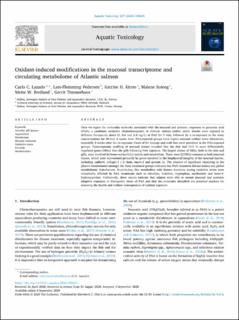| dc.description.abstract | Here we report the molecular networks associated with the mucosal and systemic responses to peracetic acid (PAA), a candidate oxidative chemotherapeutic in Atlantic salmon (Salmo salar). Smolts were exposed to different therapeutic doses (0, 0.6 and 2.4 mg/L) of PAA for 5 min, followed by a re-exposure to the same concentrations for 30 min 2 weeks later. PAA-exposed groups have higher external welfare score alterations, especially 2 weeks after the re-exposure. Cases of fin damage and scale loss were prevalent in the PAA-exposed groups. Transcriptomic profiling of mucosal tissues revealed that the skin had 12.5% more differentially regulated genes (DEGs) than the gills following PAA exposure. The largest cluster of DEGs, both in the skin and gills, were involved in tissue extracellular matrix and metabolism. There were 22 DEGs common to both mucosal tissues, which were represented primarily by genes involved in the biophysical integrity of the mucosal barrier, including cadherin, collagen I α 2 chain, mucin-2 and spondin 1a. The absence of significant clustering in the plasma metabolomes amongst the three treatment groups indicates that PAA treatment did not induce any global metabolomic disturbances. Nonetheless, five metabolites with known functions during oxidative stress were remarkably affected by PAA treatments such as citrulline, histidine, tryptophan, methionine and trans-4-hydroxyproline. Collectively, these results indicate that salmon were able to mount mucosal and systemic adaptive responses to therapeutic doses of PAA and that the molecules identified are potential markers for assessing the health and welfare consequences of oxidant exposure. | |
